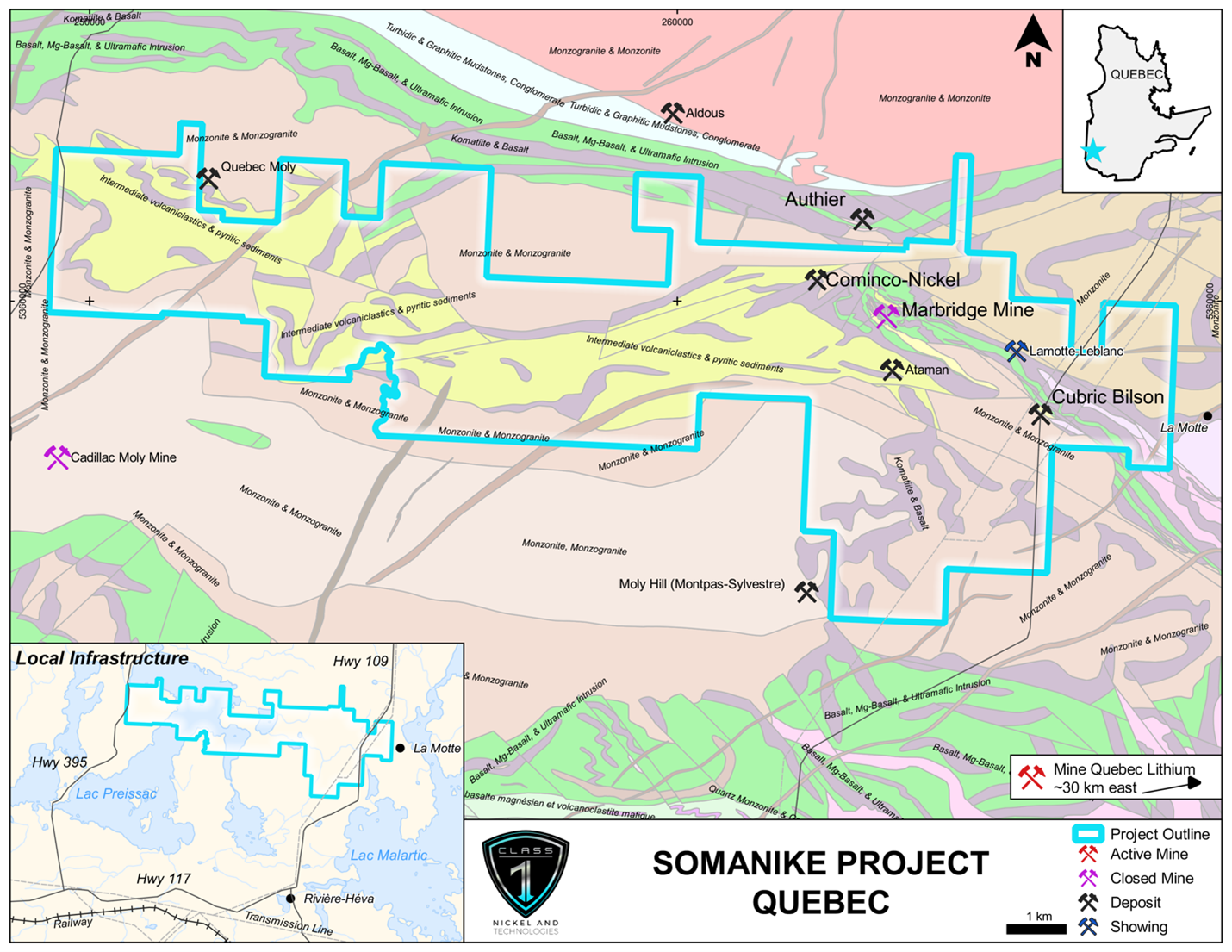Class 1 Nickel and Technologies Ltd. has declared Mr. Alex Beloborodov and Mr. Robin Adair have joined the Class 1 Nickel team to help speed exploration at the Somanike Nickel Project in Quebec, a komatiite-hosted magmatic sulfide Ni-Cu property that contains the well-known Marbridge Nickel Mine.
 Somanike Project Map. Image Credit: Class 1 Nickel and Technologies Limited.
Somanike Project Map. Image Credit: Class 1 Nickel and Technologies Limited.
- Alex Beloborodov has been appointed as the Exploration Manager for Quebec, while Robin Adair has been appointed as an Independent Geological Technical Advisor
- The ground geophysics work at the Somanike Project has received final approvals and line cutting
- Geophysique TMC’s ground electromagnetics crew is now being deployed on site for a planned 35-kilometer time-domain electromagnetic survey (TDEM)
- Prior to an intensive drilling program in 2022, TDEM deeper penetrating ground-based geophysics will be used to validate probable expansions to historic mineralization and to find new drill targets
We are excited to have Alex and Robin join the team to rapidly accelerate the exploration program at Somanike. The geophysical program underway will cover a large portion of the known historical nickel trends as well as the Marbridge Mine and will lead nicely into a comprehensive drill campaign.
David Fitch, President and Director, Class 1 Nickel and Technologies
The famed Marbridge Mine, which was Quebec’s first nickel sulfide producer, has not been drill tested in over five decades and has not been examined using advanced geophysical tools capable of locating magmatic sulfide deposits.
Alex Beloborodov is a skilled geologist who has worked in nickel, copper, and gold exploration in Quebec and Nunavut for the past 11 years. Beloborodov spent six years in nickel sulfide exploration with several greenfield and brownfield projects and also working for Canadian Royalties on an operating nickel mine. Mr. Beloborodov graduated from the Université du Québec à Montréal with a B.Sc. in Geology.
Robin Adair is a Qualified Geologist with 37 years of expertise in mineral exploration and project development, with a large amount of that time spent with Falconbridge Ltd on magmatic nickel, copper, and PGE projects in Canada. From 2014 to 2017, he worked on the Somanike Project directly. Mr. Adair graduated from the University of Alberta with a B.Sc. and an M.Sc.
Considering that most of the historical drilling and mining at Marbridge has only ever been shallow work at less than 300 m below surface, the great bulk of the project remains essentially untested. Therefore, we are all keenly interested to see the potential generation of additional nickel sulphide targets.
Alex Beloborodov, Professional Geologist, B.Sc. in Geology, Université du Quebec, Montréal
The Marbridge trend, the Ataman trend, and the Cominco showing will all be covered by the Geophysics program.
About Somanike Project
The Somanike Project is made up of 148 mining titles (mining rights areas) going to cover 6,882 hectares within one huge NW-trending ultramafic complex inside the Abitibi Greenstone Belt that contains a few nickel sulfide occurrences, recognized nickel targets, ultramafic trends, and geophysical anomalies.
The project is situated in the Abitibi area of northern Quebec, roughly 25 kilometers north of Malartic, 40 kilometers northwest of Val-d’Or, and 60 kilometers east of Rouyn-Noranda.
The Somanike Project contains the historical Marbridge Mine, which was a high-grade nickel mine run by Falconbridge Nickel and was Quebec’s first nickel mine. The Marbridge Mine is located inside a massive distorted and modified ultramafic complex that is moving northwest. From 1962 to 1968, the Mine produced 702,366 tons grading 2.28% Ni and 0.10% Cu before being placed on care and maintenance in 1968.
The mine had two shafts that led to four different mineralization zones with a total strike length of 1000 meters. The mineralized material was trucked 25 kilometers south to the Canadian Malartic factory, where it was processed.
Since 1968, prominent organizations have evaluated Marbridge data and reports and unanimously decided that mineralization has halted and that the four nickel sulfide zones are open to extension by drilling along the strike and down-dip/plunge.